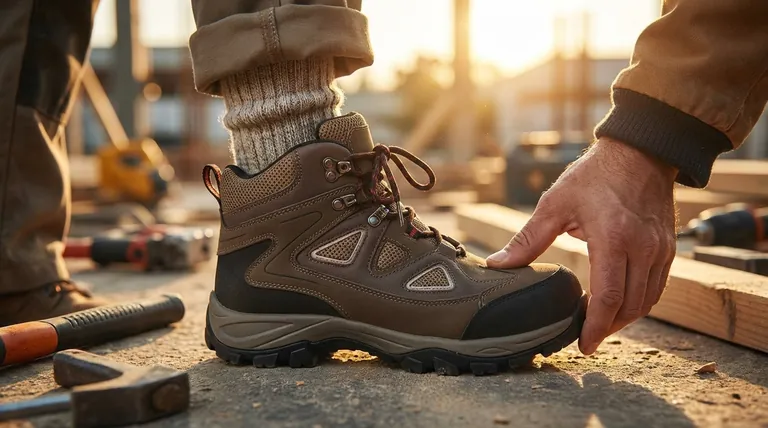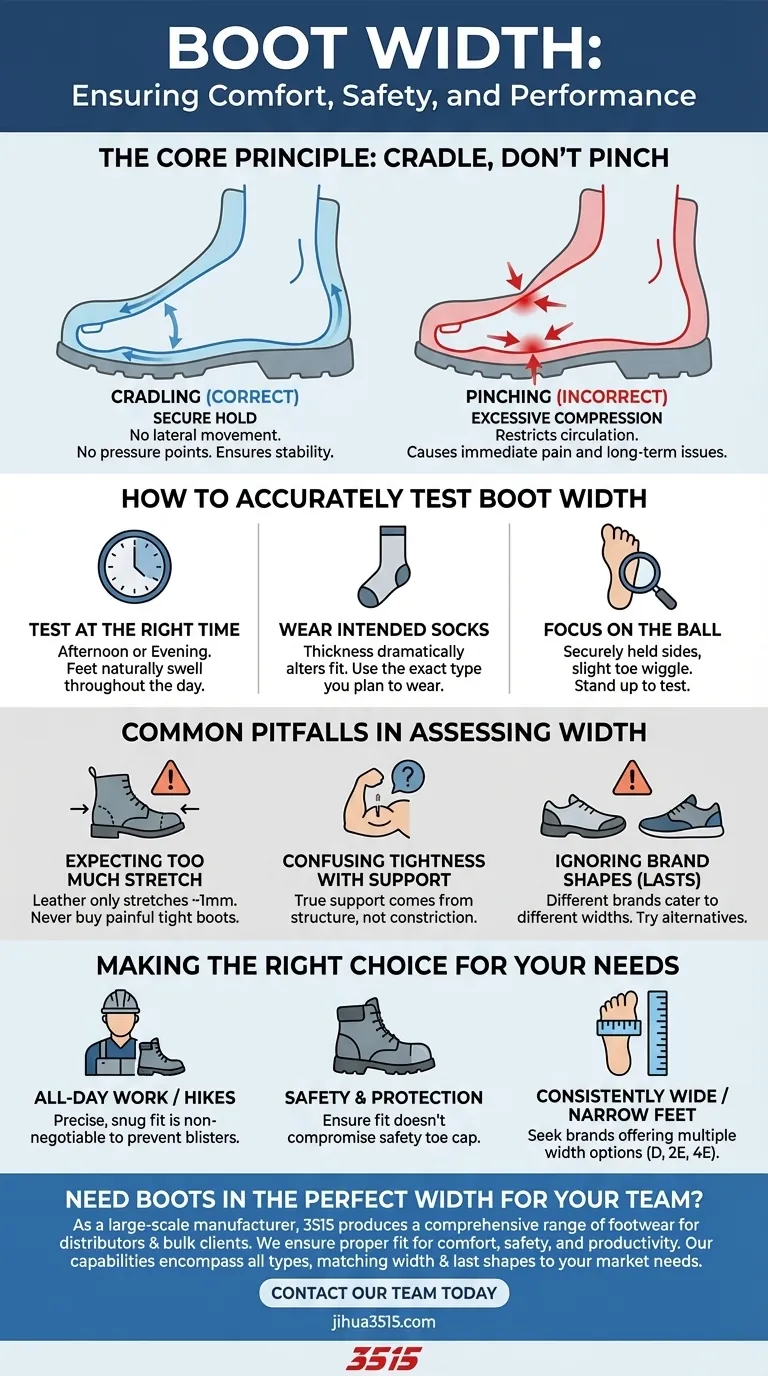When it comes to boot width, the single most important factor is ensuring the boot properly cradles the ball of your foot—the widest part—without pinching or compressing it. A correct fit should feel snug and secure to prevent lateral movement, but it must never cause pain or restrict circulation, which can lead to discomfort and inflammation.
The ideal boot width provides a secure hold that eliminates side-to-side movement without any painful pressure points. This perfect fit can only be found by trying boots on late in the day with your intended socks, as feet naturally swell and sock thickness dramatically alters fit.

The Core Principle: Cradle, Don't Pinch
The primary goal of proper boot width is to match the shape of the boot's interior to the shape of your foot. This ensures stability and comfort over long periods.
What "Cradling" Feels Like
A boot that cradles your foot makes secure contact along the sides of the ball of your foot. You should feel its presence, but not any specific point of high pressure. It prevents your foot from sliding side-to-side inside the boot when you walk or change direction.
The Danger of "Pinching"
Pinching is a sharp, localized pressure on the widest part of your foot. This excessive compression restricts blood flow and can lead to immediate discomfort, and over time, painful conditions like bunions or nerve inflammation.
How to Accurately Test Boot Width
Finding the right width is an active process that requires you to replicate the conditions under which you'll wear the boots.
Test at the Right Time of Day
Always try on boots in the afternoon or evening. Your feet naturally swell throughout the day, and a boot that feels perfect in the morning can become painfully tight by quitting time.
Wear Your Intended Socks
The thickness of your socks is a critical variable. A heavy wool hunting sock takes up significantly more volume than a thin daily-wear sock. Always test the fit while wearing the exact type of socks you plan to use with the boots.
Focus on the Ball of the Foot
Once the boot is on, stand up and pay close attention to the sensation around the ball of your foot. You should be able to wiggle your toes slightly, but the sides of your foot should feel securely held.
Common Pitfalls in Assessing Width
Many people make simple mistakes when judging boot fit, leading to poor purchasing decisions. Avoiding these is key to long-term comfort and performance.
Expecting Too Much Stretch
While leather boots will stretch slightly, this break-in period typically only adds about a millimeter of space. Never buy a boot that is painfully tight with the expectation that it will stretch to a comfortable size.
Confusing Tightness with Support
A boot should be snug, not painfully tight. New users sometimes mistake constriction for good support. True support comes from the boot's structure and a proper fit, not from simply crushing your foot.
Ignoring Specific Brand Shapes
Different brands build their boots on different "lasts," which are the foot-shaped models they use for manufacturing. Some brands naturally cater to wider or narrower feet. If one brand consistently feels too tight, it may be time to try another.
Making the Right Choice for Your Needs
Your activity dictates how critical a perfect fit is. Use your intended purpose to guide your final decision.
- If your primary focus is all-day work or demanding hikes: A precise, snug fit that eliminates all slippage is non-negotiable to prevent blisters and fatigue.
- If your primary focus is safety and protection: Ensure the fit doesn't compromise the safety toe cap, which can rub or pinch if the width is incorrect.
- If you have consistently wide or narrow feet: Seek out brands known for offering multiple width options (e.g., D, 2E, 4E) rather than trying to force a standard-width boot to fit.
Ultimately, achieving the correct boot width is the foundation for comfort, safety, and performance.
Summary Table:
| Key Consideration | Why It Matters |
|---|---|
| Cradle, Don't Pinch | Ensures stability without painful pressure points or restricted circulation. |
| Test in the Afternoon | Accounts for natural foot swelling to avoid a boot that becomes too tight. |
| Wear Intended Socks | Sock thickness dramatically alters fit; test with the socks you'll actually use. |
| Don't Rely on Stretch | Leather only stretches about 1mm; a boot should not be painfully tight when new. |
| Know Brand Shapes (Lasts) | Different brands cater to different foot widths; try multiple brands if needed. |
Need Boots in the Perfect Width for Your Team?
As a large-scale manufacturer, 3515 produces a comprehensive range of footwear for distributors, brand owners, and bulk clients. We understand that a proper fit is critical for comfort, safety, and productivity.
Our production capabilities encompass all types of shoes and boots, and we can work with you to ensure the width and last shape meet your specific market needs.
Let's discuss your requirements and create the perfect fitting boots for your customers.
Contact our team today to get started!
Visual Guide

Related Products
- Safety Footwear Wholesale Manufacturer for Custom OEM/ODM Production
- Wholesale Safety Footwear Manufacturer for Bulk & Custom OEM Orders
- Premium Flame-Retardant Waterproof Safety Boots and Shoes
- Premium Wholesale Waterproof Safety Boots High Performance Protection for Industrial Markets
- Premium High-Cut Waterproof Safety Boots Manufacturing & Wholesale Solutions
People Also Ask
- What are the cultural perspectives on wearing shoes in the house? A Guide to Home Etiquette & Hygiene
- What are OSHA approved shoes? Understanding the Correct Standards for Workplace Safety
- What are the differences between steel toe, composite toe, and alloy toe Wellington boots? Choose the Right Safety Toe for Your Job
- Do snake bite boots work? Your Ultimate Guide to Effective Snake Bite Protection
- Is safety-toe as good as steel toe? Choose the Right Protection for Your Job



















